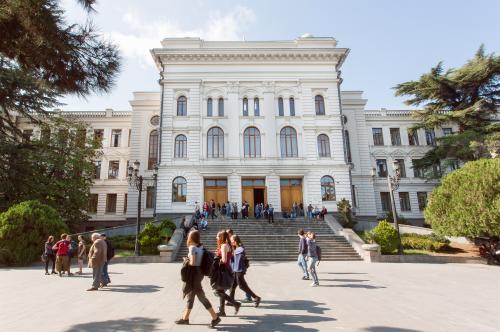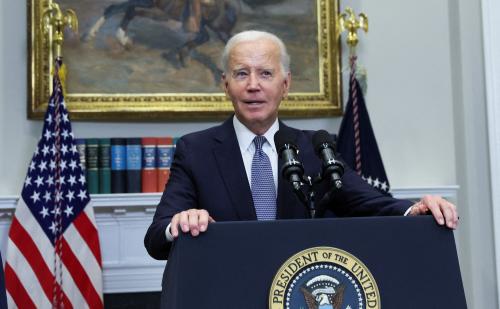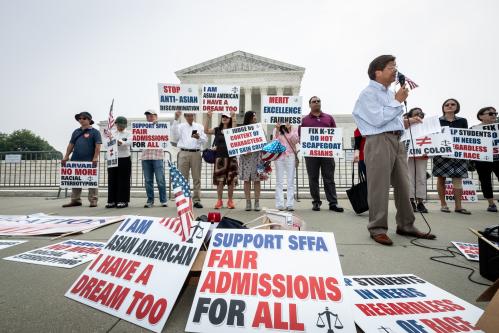While the nation is gripped with March Madness, the college sports world continues in turmoil following a decision, issued on March 8 by federal Judge Claudia Wilken, in the highly watched case In Re: NCAA Grant-in-Aid Cap Antitrust Litigation v. NCAA, or better known as the Alston case, named after one of the athletes who initially filed the case, former West Virginia running back Shawne Alston, on behalf of other former and current college athletes.
Alston had challenged the NCAA’s cap on athletic financial aid packages as an unlawful agreement to restrain trade, in violation of Section 1 of the Sherman Antitrust Act of 1890. Although the Association had lifted the cap in recent years in response to legal pressure to include not only tuition, room and board, but additional annual stipends ranging from $3,000 to $6,000 to pay for “full cost of attendance” at college, the athletes’ lawyers contended that the NCAA’s actions are no different from any agreement by employers competing for the same talent – say, graduates coming out of law school – on salary caps.
Wilken’s ruling was a major, though far from total, victory for the college athletes. She granted much of their requested relief: delegating to the athletic conferences, in place of the NCAA, the power to set any scholarship caps for the schools in their conferences. But she also placed her own cap on that power, ruling that financial aid had to be tethered to an athlete’s “educational expenses.” Wilken was specific in defining what the conferences could provide to athletes above and beyond the cost of attending college: computers, music and scientific equipment, awards tied to academic performance, for graduating, tuition for attending graduate school and stipends for internships.
In addition, Wilken left the NCAA with some residual power: the ability to impose limits on academic and graduation incentives paid in cash and to cap benefits that are “incidental to participation” in college sports, such as bowl appearance awards, insurance for loss of professional value in case of injury, and travel allowances for family members to attend the Final Four.
Finally, Wilken took the unusual step of retaining jurisdiction over all future disputes over the application of her ruling.
The NCAA almost surely will appeal Wilken’s ruling to the 9th Circuit Court of Appeals.
The qualifiers in Wilken’s opinion mean that there will not be the unrestricted free market among the athletic conferences for scholarships and payments for future college athletes, as the athlete’s attorneys — noted sports lawyers Jeffrey Kessler, David Greenspan, and Steve Berman — had urged during the trial. But there will be a lot more competition than exists now, which is to say none, because the NCAA makes all the rules. And because not all conferences will interpret the court’s guidance the same way, competition among athletic conferences – subject to further interpretations of what counts as an “educational expense” and “incidental benefits” – will determine future financial awards to athletes, after a 90-day delay which keeps current rules in place for this year’s recruiting season.
Wilken’s decision in Alston is forward looking only, and provides what lawyers call “injunctive relief”. Damages for the past effects of the NCAA’s now unlawful scholarship caps were off the table. That issue was settled in 2017, when the NCAA agreed to pay roughly 40,000 former female and male college basketball and football (males only) athletes a total of $209 million, or about $5,000 per athlete. In December 2017 the court approved the settlement.
The NCAA almost surely will appeal Wilken’s ruling to the 9th Circuit Court of Appeals. The NCAA must be hoping that the appellate court will cut back or even reverse Wilken’s decision in some way, as it did when it overturned a portion of her 2014 ruling in the O-Bannon case. That was a matter brought by former UCLA basketball star Ed O’Bannon (the MVP of the team’s 1995 NCAA championship) on behalf of male basketball and football players claiming that the Association’s prohibition on athlete’s compensation for their images or likenesses, in video games and on television, violated the Sherman Act, a claim with which Wilken agreed. Wilken added the schools could put up to $5,000 per year a student competed in a trust fund that could be accessed later.
The 9th Circuit struck down the trust fund idea on the grounds that it was “untethered to educational expenses,” but upheld the verdict that the prohibition against any compensation was unlawful while also restricting athletic awards to the full cost of attending school. The NCAA appealed the 9th circuit ruling to the Supreme Court, which declined to take the case.
In doing so, she made an all-but-certain appeal by the NCAA more difficult to be reversed this time around.
Wilken was clearly mindful in writing her Alston opinion of the appellate court’s O’Bannon ruling because she used the same “tethered to educational expenses” qualifier. In doing so, she made an all-but-certain appeal by the NCAA more difficult to be reversed this time around.
Although the appeals process will continue for some time, it is not too early to speculate on the NCAA’s future, and that of college sports, more broadly, in the wake of Wilken’s big ruling. Here are some obvious questions with some tentative answers.
How would the conferences compete against each other in setting athletic scholarship rules, and what are some of the likely outcomes from that competition?
The truth is no one knows, but the laws of economics help provide a good guess.
As in any competitive market, competitors are likely to bid up the amounts they are willing to pay for what they need. And colleges that have active sports programs need star athletes, especially in the “big money” sports of basketball and football, which generate not only game-day ticket sales, but proceeds of broadcasts of their games. As it is now, much of this money, after operational expenses, now goes to pay for coaches, who now benefit from the free market to which the players are denied, and to support other endeavors at the university, including subsidies to the non-big money sports, such as swimming, baseball, track and volleyball, among others.
One question is whether any conferences would try to compete for recruits on the value of the education they provide, plus incidental spending money, or whether all would set caps at much higher amounts, well above the full cost of attendance. Judge Wilkens’ requirement that total athletic compensation be “tethered” to educational expenses will put a ceiling on all this, but how exactly how high – meaning what constitutes “tethered to education” – eventually will be decided in one or more future cases, perhaps brought by one or more conferences against another conference thought to be too generous to its athletes.
How would competition between conferences affect sports programs outside basketball and football, especially the schools’ obligations to afford opportunities for women athletes required under Title IX of the Education Act Amendments of 1992?
With more money going out primarily to male athletes in the money sports of basketball and football in a more competitive environment, a natural question to ask how, if at all, this could change the lineup of university sport programs. With presumably less money left over after higher payments to male basketball and football players, won’t Division I schools cut back on their subsidies for other sports, and in the process curtail opportunities for women athletes to compete?
A school can offer men’s football but doesn’t need to offer women’s football.
Title IX prohibits discrimination based on sex in college athletics. Women must be afforded equal opportunities to participate in athletics, but there is nothing in Title IX requiring that schools offer identical athletic sports programs for men and women athletes. A school can offer men’s football but doesn’t need to offer women’s football. Rather, the Office of Civil Rights of the Education Department, which enforces Title IX, looks at the overall sports program offered by each university to determine compliance, counting the number of male and female athletes, rather than the number of sports in which each are participating.
It is clear from Title IX that, if allowed to compete based on their compensation rules, the conferences could not set one, presumably higher, limit for male athletes than for women. As the NCAA’s website states in respect to Title IX: “The basic philosophical underpinning of Title IX is that there cannot be an economic justification for discrimination. The institution cannot maintain that there are revenue productions or other considerations that mandate that certain sports receive better treatment or participation opportunities than other sports.”
But what if, as a practical matter, schools were to pay more for, say, male basketball players, on average or for superstar athletes, because those players earn more revenue for the university than female basketball players (at all schools except perhaps the University of Connecticut)? Another part of the NCAA’s website discussion of Title IX would seem to allow this where it says: “Variations within the men and women’s program are allowed, as long as the variations are justified.” But this language contradicts the earlier language that Title IX was put in place precisely in order to prevent economic considerations for leading to unequal treatment of male and female athletes.
In short, there is no clear answer whether a ruling by Judge Wilken in favor of the athletes could justify a market-driven disparity in athletic compensation for male and female athletes.
In short, there is no clear answer whether a ruling by Judge Wilken in favor of the athletes could justify a market-driven disparity in athletic compensation for male and female athletes. Such an outcome was not before her in Alston, although down the road it would not be surprising if one or more female collegiate athletes later bring a Title IX challenge to future compensation disparities. Earlier this March, the U.S. soccer team sued the U.S. Soccer Federation in the federal court in Los Angeles alleging pay discrimination arising from market-determined revenue differentials for men’s and women’s soccer. Although this case doesn’t involve college athletes, the principles involved are the same, and thus the outcome of the soccer litigation could affect whether any future Title IX suit might be brought, and if so, its prospects for success.
Would D-1 schools that pay more than cost of attendance cut back other sports, both for men and women, because they are no longer being cross-subsidized? Title IX may constrain the ability of schools to do this, since that could limit athletic opportunities for women. If that is the case, schools may choose to cut their coaches’ salaries in basketball and football in order to retain their other programs. No wonder few basketball and football coaches have supported allowing schools to pay their athletes in these sports more than the full cost of attendance.
What would happen to the mid-majors in Division 1 basketball and to schools in Divisions II and III?
Allowing conferences to compete in the setting of rules on player compensation would most immediately lead to increased athletic compensation for athletes playing the “money sports” at schools in the “power conferences” – the Pac-12, the ACC, the American, Big Ten, Big Twelve, and possibly the Big East and the WAC – since these conferences have schools with the largest stadiums and whose games are televised most frequently on the major networks, ESPN and Fox Sports. A natural question to ask is whether a more competitive market for recruits would severely disadvantage the mid-majors or the smaller schools in Divisions II and Divisions III that cannot afford to pay large sums for prized athletes?
The short answer is likely “not very much” for the mid-majors, and “virtually no effect” for the smaller Division II and III schools. The reason is that there are only so many blue-chip recruits coming out of high school or available from foreign countries (as is increasingly the case in basketball), and they are already allocated heavily toward the power conference schools, even with the current scholarship limits. That is because the best athletes typically want to attend schools that give them the best shot at playing at the next level – professionally – as well as on prime TV broadcasts so their families and friends can see them play without having to travel to every game.
The NCAA would not like that outcome
Still, it is likely that some mid-major schools would find themselves unable to compete in a more open market for certain star athletes who under the current rules prefer, for any number of reasons – being closer to home, wanting to be a bigger fish in a smaller pond, or because they really like a particular coach – to attend a mid-major school. In a world in which power conference schools offer more money to these recruits than the mid-majors, that could tip the balance for some star recruits who would otherwise pick a mid-major to choose a power conference school instead. That, in turn, could reduce the chances of success of the mid-majors, slim as it already is, who make it to the March Madness basketball tournament.
The NCAA would not like that outcome, knowing that viewership of the tournament is expanded by the potential for upsets by Cinderella schools. As unlikely as it may seem now, that fact could eventually induce member schools of the NCAA, which still would be collecting broadcasting rights fees on behalf of all Division-1 schools, to devote some portion of the proceeds to subsidizing the mid-majors. Developing the formula for such a revenue sharing arrangement would be difficult – based on some combination of factors, average tuition revenue of the schools, the numbers of full-time students, and so on — but not impossible. It is now done in the NFL for professional football, in the NHL for professional hockey, and in Major League Baseball.
How would conference competition affect fans, ticket prices, broadcasting rights, and other sources of revenue for collegiate athletics?
In its defense of amateurism, the NCAA had some of its witnesses assert that fan and donor support would decline if college athletes were paid. But none of the NCAA’s witnesses during the trial advanced any survey or other quantitative estimates to back up these claims. In contrast, one of the athlete’s experts, Dan Rascher of the University of San Francisco noted that past increases in athletic scholarship awards have not caused fan interest to dwindle. Moreover, Wilken made clear in her opinion that she continued to accept the importance of amateurism but rejected the NCAA’s exclusive role in defining it.
The truth is, no one really knows what would happen to fan and donor support
The truth is, no one really knows what would happen to fan and donor support, at least initially, if athletes were paid considerably more than they are now. If the fan response were substantially negative, it is likely that the conferences – driven by fan attendance and television ratings – would respond by lowering any caps they will put in place. Like any other market, colleges and the conferences representing them almost surely will do what they can to preserve their cash cows.
Another question is what would happen to ticket prices and fees for broadcast rights. At first blush, one might think that if colleges were paying more to their athletes, they would pass the increased cost forward into higher ticket prices and successfully demand more for broadcast rights when the current contracts expire.
But economic theory suggests otherwise. In competitive markets, prices are set by the interaction of supply (or cost) and demand. If the NCAA’s witnesses are correct that fan support will fall once athletes are paid more than the current full cost of attending college, then demand for tickets presumably would fall. Other things being equal, this would drive ticket prices down, and not up.
What about supply or costs? Economic theory has long held that the willingness of firms, or in this case colleges, to supply their products or service depends on their “marginal” costs, or the cost of producing an extra unit in the case of manufactured items, and in the case of college sports, presumably the cost of playing another game. The per game costs do not vary with the costs of paying coaches and their players, which are fixed costs, analogous to the overhead costs of a typical firm. About the only costs that do vary are the costs of operating the stadium for another game – the costs of security, preparing and clean the field or the court, and the energy costs required to power the lights, heating or air conditioning (in the case of indoor arenas). None of these operating costs are touched by athletic scholarship and compensation rules, whoever issues them.
In short, freeing conferences to raise athletes’ compensation should not increase ticket prices and could even induce their decline if fan interest falls. But as just noted, if enough fans quit showing up, that is likely to induce conferences to tighten any initial limits that they may impose on scholarships and athletes’ compensation.
The same is true of broadcast fees. If fan interest falls, the TV networks will reduce the amounts they are willing to pay for broadcast rights. But here, too, the conferences are unlikely to take any such negative reaction lying down, and instead would be driven to do what it takes – including the tightening limits on athletic scholarships if that is what fans were demanding.
What Will Happen to the NCAA?
In the runup to Wilken’s ruling there some was speculation that if the NCAA’s power to set limits on financial awards to athletes were transferred to the conferences, that would spell the end of the NCAA. That is not likely to be the case, for several reasons.
For one thing, the Alston ruling was limited only to athlete’s compensation, which leaves untouched other things the NCAA is now doing. Thus, the Association almost surely will continue to stay in the business of setting safety and minimum academic standards for athletes, which involve rules about the games, such as what kinds of blocks are illegal in football, or what constitutes a “flagrant” penalty and what should that penalty look like in basketball? These safety-related issues and minimum academic standards could be decided at the conference level, but without colluding the conferences could individually determine that it is better for sports if one central body sets such rules.
the Alston ruling was limited only to athlete’s compensation, which leaves untouched other things the NCAA is now doing.
The other natural functions of the NCAA are to host and administer championship tournaments and to negotiate broadcast rights for those events the television networks or channels believe they can support through advertising or subscription (for cable) revenue. The broadcast negotiation function for basketball and football has already been eroded, however, by television packages the various power conferences have negotiated. But the NCAA still bargains on behalf of all D-1 schools for the rights to show the college football championship games and for the post-season college basketball tournament, “March Madness.” It is in the interest of the conferences to let the NCAA to continue these functions, for they span across all conferences.
Perhaps most importantly, as noted at the outset, Wilken’s opinion allows the NCAA to set, and thus presumably enforce, limits on academic or graduation cash incentives (but not awards paying athletes for graduate school and other lawful purposes) and benefits “incidental” to athlete’s participation. In addition, her opinion allows the NCAA to limit compensation and incentives that are “unrelated to education,” but bars the organization from continuing to limit any amounts tied to education. All these “split the baby” qualifiers keep the NCAA in the compensation game, just not the only team on the floor. Most of the action on compensation under Wilken’s ruling would move to the conferences, which presumably would take on some of the enforcement staff now working for the NCAA (although the conferences could look to other sources for their staff).
Has Judge Wilken Become the New NCAA?
If Wilken is allowed to retain her power, then she will have replaced the NCAA
Unusually, Judge Wilken retained jurisdiction over future athletic compensation matters. This means that any future litigation over the meaning of “educational expenses,” perhaps launched by one or more of the conferences against another “renegade” conference, or even a future challenge to the limits the NCAA may impose on education related awards which Wilken allows, will be in her courtroom, or when she retires, presumably in the hands of another judge in the Northern District of California, again assuming that the appellate court lets that happen (which it might not). If Wilken is allowed to retain her power, then she will have replaced the NCAA, along with the conferences, in deciding what is ultimately allowable for the schools to pay athletes.
In that sense, Judge Wilken could become to college sports what Judge Harold Greene became to the telecommunications industry for a little more than a decade after he approved a settlement between the Justice Department and the AT&T that broke up “Ma Bell.” Greene was petitioned constantly by new “Baby Bells” and other parties about the limits of settlement and accompanying consent decree, until Congress took those decisions out of his hands when it enacted the 1996 Telecommunications Act.
Will the NCAA Eventually Turn to Congress, and if so, Will it Win Back its Authority?
The telecommunications precedent raises the obvious possibility that the NCAA could try to get Congress to overturn any judicial rulings against it by, in effect, asking lawmakers to carve out an exemption or set a more relaxed standard for scholarship limits under the antitrust laws. But that assumes that the interests of all NCAA members schools would be aligned once conferences begin competing against each in setting limits on financial packages for athletes.
This is not necessarily the case. As noted above, some mid-major schools, or schools belonging to conferences outside the power conferences, could want a return to the status quo so they have better chances of landing star recruits. Many if not most schools in the power conferences would not agree.
The NCAA, therefore, could be sidelined from lobbying Congress for restoring the status quo.
The NCAA, therefore, could be sidelined from lobbying Congress for restoring the status quo. This needn’t impair the other functions of the NCAA just discussed, but it could lead to joint efforts by the mid-majors – all of them together or in different groupings – to pursue legislative action. How might they fare in this highly partisan political atmosphere?
Partisanship may not matter much here, though, because antitrust enforcement, especially against price or wage fixing in sports, has not been a highly political matter. Progressive Democrats recently have shown greater interest in halting mergers or breaking up monopolies, especially in the tech industry, but so far elected members of neither party have shown much interest in the application of the antitrust laws to collegiate athletics.
Accordingly, Congressional reaction to any push to overrule a pro-athlete decision in the courts likely would become a traditional constituent issue. If so, then mid-majors might be successful in enlisting the support of House members in districts where those schools are located, and perhaps a few Senators who are alums. But House members in districts that are home to power conference schools and Senators who represent entire states – and thus would balance the claims of the power conference schools in their state with mid-majors – would be less likely to support any exemption. Of course, some older elected officials, used to the idea of amateurism in collegiate athletics, could be offended by Wilken’s ruling and support a return to the status quo for this reason alone.
At this early stage, it is impossible to know whether a push for a legislated exemption for athletic compensation under the antitrust laws would be successful. But who knows what will happen over time?
College sports, welcome to the marketplace, and continuing struggles in the courts and perhaps in Congress. You’ll be living like the rest of us.
Robert E. Litan is a Non-Resident Senior Fellow at the Brookings Institution, and a practicing attorney and partner with Korein, Tillery, a law firm based in St. Louis and Chicago. In 2003, Litan co-authored an independent study for Sebago Associates and commissioned by the National Collegiate Athletic Association entitled “The Empirical Effects of Collegiate Athletics.” However, the author did not receive any financial support from any firm or person for this article or from any firm or person with a financial or political interest in this article. He is currently not an officer, director, or board member of any organization with an interest in this article.







Commentary
College sports joins the marketplace, with limits
March 19, 2019